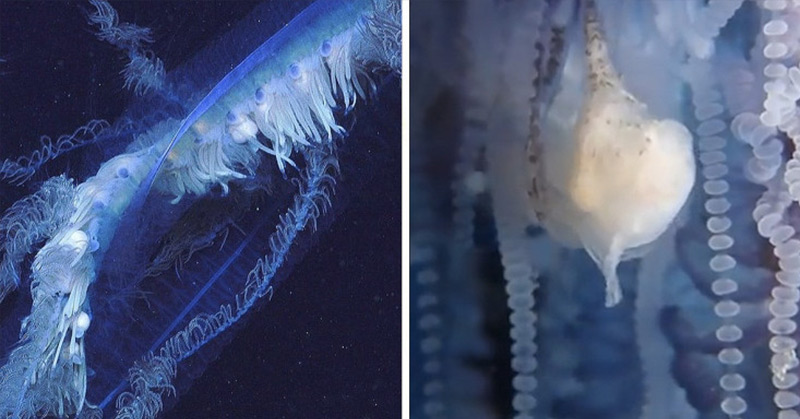The deep sea is full of fascinating- albeit terrifying- creatures, that look more like they jumped out of the pages of a sci-fi novel rather than real life. For the general public, images of these creatures can often be jarring, but for ocean scientists, they’re simply a part of everyday life. Every so often, however, scientists stumble upon a creature that leaves even them baffled.
A Stringy Stingy Thingy
A team of researchers may have discovered the longest living thing in the world. Known by scientists as a siphonophore Apolemia, the creature resembles a giant alien tentacle [1]. A siphonophore belongs to a group of animals called Cnidaria, which includes corals, hydroids, and jellyfish. There are about 175 species, and they are the longest animals in the world. Most siphonophores consist of clear, often bioluminescent (aka- glowing) gelatinous material, and are very fragile, breaking into many pieces under even the slightest forces [2].
A Colony

Although it appears to be a single entity, a siphonophore is actually a colony of tiny, genetically identical clones that have strung themselves together to work as a team. Marine biologist Stefan Siebert of Brown University, explains that these tiny bodies actually function kind of like organs. “Some move the colony, some feed for the colony, some take care of reproduction,” he said [3]. The massive creature was spotted about 630 meters below the water’s surface west of Australia in the Indian Ocean, in a region called the Ningaloo Canyons. It is the largest siphonophore ever recorded and was found positioned in a “UFO-like” feeding coil.
Exciting Discovery

While they were unable to get a full measurement of the creature’s inner rings, the outer rings measured 47 meters in length [1]. Biologists Nerida Wilson and Lisa Kirkendale of the Western Australian Museum described their excitement upon its discovery. “Everyone was blown away when it came into view,” they said. “There was a lot of excitement. People came pouring into the control room from all over the ship. Siphonophores are commonly seen but this one was both large and unusual-looking.” [4]
Read: Woman Shares Photos of an Amazing Flower-Like Bug That Looks like A Work of Art
A Deadly Creature

According to the Schmidt Ocean Institute, this “thing” appears to have a snake-like body, but it has fur spilling out one side. That fur is actually made up of tentacles containing powerful neurotoxins, and are designed to capture prey [1,3]. These “feeding bodies” envelop the prey, such as a small shrimp, digest it, and disperse it to the rest of the colony. The jet propulsion bodies at the front of the creature require the most nutrition, since they have to work hard to suck water in then squirt it out again in order to get the creature moving [3].
Scientists Still Unsure

Scientists, however, are still unsure as to how all of the separate tiny bodies communicate to ensure that the siphonophore moves en masse, since it has no brain to organize everything. “[Siphonophores] have along the stem one long axon, which probably propagates signals from one end of the colony to the other,” Siebert said. “But how they coordinate all this and how the whole colony appears to act as an animal, it’s really not well understood.” [3] What makes this creature remarkable, is that rather than simply waiting to entrap whatever food passes by, the siphonophore actually hunts for food. This particular siphonophore, however, appears to be hunting in a galaxy-like spiral.
Unique Creature

“I’ve gone on numerous expeditions and have never, EVER, seen anything like this,” said biologist Rebecca Helm [1]. Another interesting difference between siphonophores and other deep-sea creatures is their color. It is very common for deep-sea creatures to be bioluminescent (aka- glow) in order to attract prey, but most of them glow green or blue, since those colors transmit the furthest underwater. This particular species of siphonophore, however, glow red, in order to resemble another creature called a copepod. Copepods are a favorite meal for many creatures in the deep, and copying them is a great way to attract prey [3].
Read: Dozens of Creatures Thought to Be Extinct Found Alive in ‘Lost City’ in the Jungle
Not a Real Threat to Humans

If the images of this terrifying creature have you rethinking your next sunny beach vacation, you can put your mind at ease- it is very rare for humans to come into contact with siphonophores [1]. The only siphonophore you might be familiar with is the Portuguese man-of-war. They are very different from the elongated siphonophores found in the depths of the ocean and are more similar in appearance to jellyfish than anything else.
The Bottom Line

Occasionally, the man-of-war’s tentacles can become detached in rough seas and drift to shore, where an unsuspecting swimmer might get a nasty sting. These stings can be incredibly painful but are rarely deadly [3]. For the most part, however, siphonophores and humans live in blissful ignorance of one another, and unless you decide to become a deep-sea biologist, you will likely never get up-close and personal with one.
Keep Reading: When Researchers Discovered an Underwater Volcanic Range it was Teeming With New Scary-looking Fish Species


